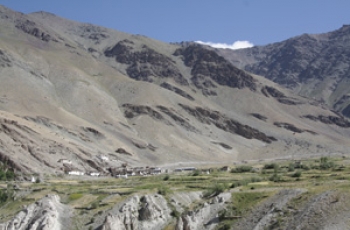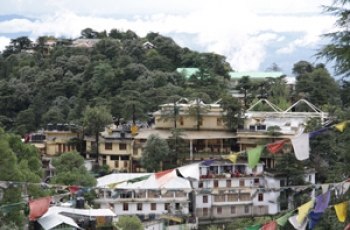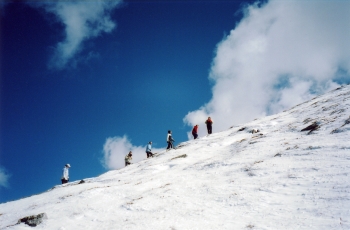Mountain sickness
- Acute Mountain Sickness(AMS) is the most common and is not life-threatening
- HACE (High Altitude Cerebral Edema) is a life-threatening illness that usually develops from AMS
- HAPE (High Altitude Pulmonary Edema) is a life-threatening illness; it may occur on its own, or with AMS or HACE These three presentations of altitude illness can vary from mild to severe. Note: Altitude illness, hypothermia and dehydration often occur together; check for these conditions and treat accordingly.
Preventing AMS, HACE and HAPE
- Gain altitude slowly. As a rough guide, above 2500m/8200ft, the maximum height gain between sleeping altitudes should not exceed 300m/1000ft per day, with a rest day for every 1000m/3300ft of ascent or every third day. Only ascend when there are no symptoms of AMS
- Avoid over-exertion and avoid getting out of breath while acclimatizing, especially if experiencing symptoms of AMS
- Drink enough liquid to keep your urine pale and plentiful (an increased urine output after an ascent is a good sign while a decreased urine output indicates that altitude illness is developing)
- Avoid alcohol, caffeine, excess salt and too much protein; ideally your diet should be 70% carbohydrate above 3500m/11500ft)
- Use the 'buddy system' to keep an eye on each other for symptoms of AMS
- Avoid medications that depress respiration (e.g. sleeping tablets, sedatives, strong painkillers and antihistamines) as these increases the risk of AMS. If you must take any of these medications, take Diamox TM as well
- If you must fly or drive rapidly to 2500m/8200ft or higher, spend a minimum of two nights at your arrival altitude (or lower if possible) or till symptoms disappear, before ascending. If ascending rapidly to 3000m/10000ft or higher, consider using DiamoxTM (125 to 250 mg 12-hourly, start at least one day before your initial ascent and continue for at least 3 days after arrival). Diamox helps acclimatization and will not mask the symptoms of AMS
Acute Mountain Sickness (AMS)
AMS is common; depending on the altitude gained and the speed of ascent, incidence ranges from 20 to 80%. Typically symptoms appear anytime during the first 36 hours after an ascent. If you rest at the same altitude, symptoms usually disappear quickly (but this can take up to 4 days) and you are now acclimatized to this altitude. AMS may reappear as you ascend higher still, and acclimatization has to occur again.
Symptoms are due to fluid accumulation in brain tissue and vary from mild to severe; it can progress to HACE if it is ignored. People often blame cold-heat-infection-alcohol-insomnia
exercise-unfitness-migraine for their AMS symptoms and carry on up. To continue ascending with symptoms of AMS is dangerous and has led to many deaths.
NB. It may be quite difficult to tell if a young child is developing AMS. The only symptoms may be increased fussiness, crying, loss of interest or loss of appetite.
Symptoms & signs
-
Headache (typically throbbing, often worse for bending over or lying down), PLUS one or more of the following symptoms:
- Tiredness, lassitude
- Dizziness, light headedness
- Nausea (or vomiting)
- Loss of appetite
- Insomnia, disturbed sleep, frequent waking
Treatment
- Rest (avoid even the slightest exertion if this is possible) at the same (or lower) altitude until the symptoms clear (up to 4 days)
- Drink enough to keep your urine pale and plentiful
- Use ibuprofen or paracetamol for headache
- Consider DiamoxTM (125 to 250 mg 12-hourly) for 3 days, or for the. rest of the time at altitude if symptoms return
- Consider Stemeti TM (or other anti-vomiting medication) for persistent nausea/vomiting
- If AMS symptoms are severe, give oxygen (1 to 2 L/min) OR use a pressure bag until symptoms clear
- Check the victim regularly for signs of HAPE and HACE, especially during the night .
- Descend far enough to clear symptoms (at least 500m/1700ft) if symptoms of AMS do not improve or get worse.
Periodic (Cheyne Stokes) breathing
This unpleasant condition occurs while sleeping at altitude. If someone suffers from it, always check them for symptoms of altitude illness.
Symptoms & signs
- Short periods of normal or fast breathing followed by breath holding then several gasping breaths. This can be quite frightening for the victim's buddy
- The victim often wakes feeling like they are suffocating
- Sleep is disturbed and of poor quality
Treatment
Give Diamox, 'the high altitude sleeping pill', 125-250 mg at night or 12-hourly.
Notes on acetazolamide (DiamoxTM)
This is a mild diuretic, which acidifies the blood thus improving respiration and acclimatization. There are three reasons for using DiamoxTM: prevention of AMS, treatment of AMS, and for sleeping difficulties.
Prevention of AMS
There is good evidence that Diamox TM is effective for preventing AMS. However, routine preventative use for all trekkers on all treks is NOT recommended.
Preventative use is recommended for those who have a past history of Altitude Illness, or when rapid height gain is unavoidable.
Poor sleep
This is a common problem at altitude. First line of treatment for insomnia is check warmth of sleeping bag, decent insulation and advise no caffeine. DiamoxTM, which acts as a respiratory stimulant, is indicated for sleep disturbance at altitude, particularly where this is associated Nith periodic breathing (repeated bouts of stopping breathing followed by gasping breaths).
Some altitude physicians refer to DiamoxTM as 'the high altitude sleeping pill'. The starting dose is DiamoxTM 125mg (half a tablet) an hour before going to bed. (If symptoms persist try 125 mg twice daily. If that doesn't work, try 125 mg in the morning and 250 mg at night).
Diamox; allergy and side-effects
DiamoxTM may cause an allergy in some people. It must be avoided if there is past history of an adverse reaction to DiamoxTM or sulfa containing drugs (eg. SeptrinTM, BactrinTM). Some common side effects of DiamoxTM:
- Extra urine output. Worries about this tend to be exaggerated. Keep your urine pale and plentiful. Use a pee bottle (SanifemTM or TupperwareTM box for women), at night in tents or lodges to avoid getting cold or falls while going out to the toilet.
- The most obvious side effect is paraesthesia (tingling) in lips, fingers, toes, and a metallic taste when drinking carbonated drinks. Both symptoms are milder with lower doses and disappear on stopping the medication.
- DiamoxTM can cause a person to sunburn more easily ('photosensitivity').
A common concern about DiamoxTM is that it will mask the onset of altitude illness. There is no evidence that DiamoxTM masks the onset of AMS, HACE or HAPE. However, DiamoxTM is not guaranteed to work so even if someone is taking DiamoxTM, and AMS, HACE or HAPE may still develop.

Lamayuru-Darcha Trek
Destinations:Ladakh/Zanskar...
Trip Duration:25 Days
Best Time:May - Nov
View Details
LADAKH-DHARAMSHALA TOUR
Destinations:Dhramsala-Ladakh...
Trip Duration:16 days
Best Time:May - Nov
View Details
Nun Kun Expedition
Destinations:Delhi - Leh - kargil...
Trip Duration:24 days
Best Time:May - Nov
View Details
Spiti - Kinnaur - Ladakh tour
Destinations:Kalpa-Kaza-Ladakh...
Trip Duration:15 days
Best Time:May - Nov
View Details
Manali Leh Mountain Bike
Destinations:Manali - Serchu - Je...
Trip Duration:15 Days
Best Time:May - Nov
View Details




